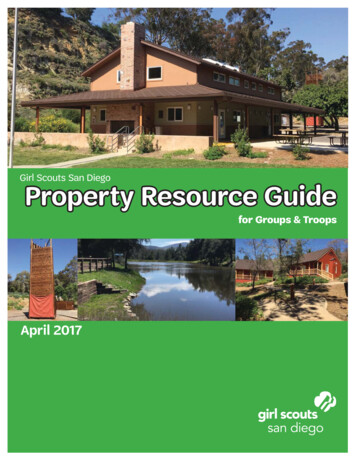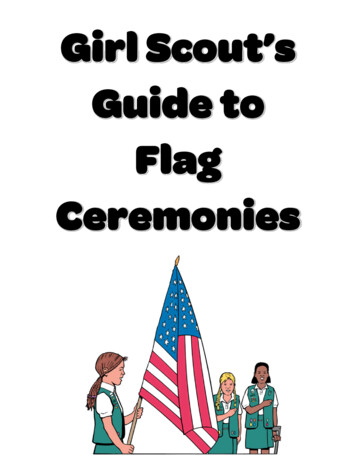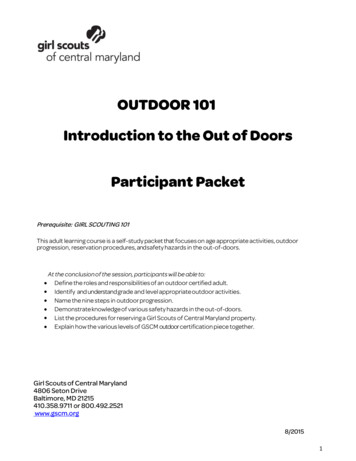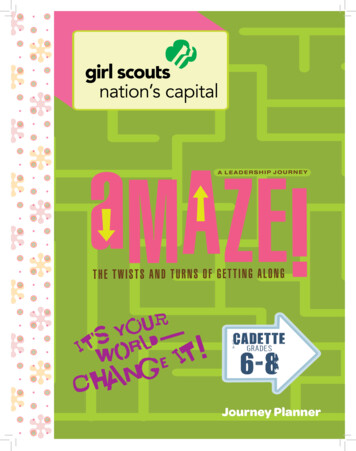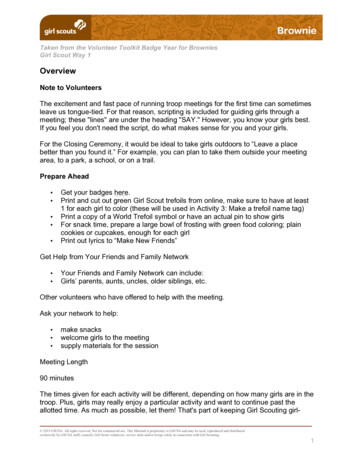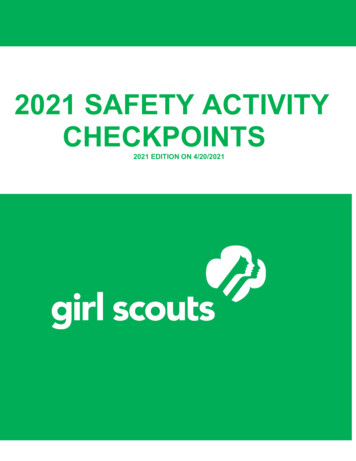
Transcription
-2021 SAFETY ACTIVITYCHECKPOINTS2021 EDITION ON 4/20/20211
Table of ContentsGirl Scout Activity Safety Standards & Guidelines . 4Coronavirus Safety in Girl Scouts . 5Have an Emergency Action Plan (EAP). . 6Understanding Which Activities Are Not Permitted . 11Chartered Aircraft Trips and Aviation . 12Other Actions Girls and Volunteers Should Not Take . 12First Aid . 12Overall Health, Well Being and Inclusivity . 15Transporting Girls . 17Troop Meeting Space . 19Activities at a Glance . 21Aerial Fitness. 34Amusement Parks . 36Animal Interaction . 37Backpacking . 41Bicycling . 43Camping . 46Climbing and Adventure Sports—Master Progression Chart . 50Challenge Courses . 51Climbing and Rappelling . 53Recreational Tree Climbing . 56Zip Lining . 58Computer and Internet Use . 60Computer Internet Safety Pledge . 63Virtual Troop Meetings. 64Cookie and Product Sales . 67Cross Country Skiing . 69Downhill Skiing and Snowboarding . 71Fencing . 73Fishing and Ice Fishing . 75Geocaching . 79Go-Karting . 81Hayrides . 83Hiking . 85Horseback Riding . 87Ice Skating and Roller Skating . 90Indoor Skydiving . 92Indoor Trampoline . 94Inflatables . 96Miscellaneous Activities . 98Offshore Water Vessels . 99Orienteering. 103Outdoor Cooking . 105Parades and Other Large Gatherings . 110Paddling and Rowing Sports—Master Progression Chart . 112Canoeing . 114Corcl Boats . 118Kayaking . 120Row Boating . 1242
Standup Paddle Boarding . 127Whitewater Rafting . 130Pocket Knife and Jackknife Safety . 133Sailing . 134Scuba . 137Sledding and Tobogganing . 140Snorkeling . 142Snowshoeing . 144Spelunking/Caving. 146Surfing . 148Swimming . 150Swimming Test – Documented Verification of Completion . 153Target Sports. 155Archery . 158Ax, Knife, and Hatchet Throwing . 160Slingshot . 163Tools – Hand and Power . 166Tethered Hot Air Balloon Rides . 169Travel / Trips . 171Tubing . 177Waterskiing and Wakeboarding . 179Wind Surfing179GSCB Offered and Required Trainings180Printable Checklist for Drivers1813
Girl Scout Activity Safety Standards & GuidelinesSafety Activity Checkpoints (SAC) is a resource that provides safety standards and guidelines for Girl Scoutsof the United States of America (GSUSA) approved activities.GSUSA, local councils, and other units holding a credential – including USA Girl Scouts Overseas (USAGSO)– shall be responsible for seeing that all activities are planned and carried out in a manner that considers thehealth, safety, and general well-being of all participants in accordance with these guidelines.This section provides general safety standards & guidelines by topic that will apply to all activities. Please readand become familiar with all topics in this section. These standards and guidelines are to be used together withthe specific safety checkpoints for an individual activity along with reasonable common-sense adjustments toensure a safe positive experience for girls. The intent of providing these guidelines is to establish a checklistfor success and develop confident leaders.Adult Supervision. There are different adult supervision requirements for Girl Scout troop meetings ascompared to events outside of the regular Girl Scout troop meeting such as outings, activities, camping andtravel. Activities and travel outside of the regular troop meeting space require more adult supervision.For Troop MeetingsThe adult-to-girl ratio is two unrelated volunteers, including one female, for up to this number of girls: 12 Girl Scout Daisies20 Girl Scout Brownies25 Girl Scout Juniors25 Girl Scout Cadettes30 Girl Scout Seniors30 Girl Scout AmbassadorsThere should be one extra adult for every additional: 1–6 Girl Scout Daisies1–8 Girl Scout Brownies1–10 Girl Scout Juniors1–12 Girl Scout Cadettes1–15 Girl Scout Seniors1–15 Girl Scout AmbassadorsFor Outings, Activities, Travel and CampingThe adult-to-girl ratio is two unrelated volunteers, including one female, for up to this number of girls: 6 Girl Scout Daisies12 Girl Scout Brownies16 Girl Scout Juniors20 Girl Scout Cadettes24 Girl Scout Seniors24 Girl Scout Ambassadors4
There should be one extra adult for every additional: 1–4 Girl Scout Daisies1–6 Girl Scout Brownies1–8 Girl Scout Juniors1–10 Girl Scout Cadettes1–12 Girl Scout Seniors1–12 Girl Scout AmbassadorsSome high-risk activities may require more adult-to-girl supervision than stated above. For those activities, thesafety checkpoints will provide the specific ratios required. Remember, some activities are less safe foryounger girls, particularly Daisies and Brownies. Younger girls may not be permitted to participate based ontheir age, as appropriate, and this will be specified on the individual activity. In cases where younger-girlparticipation is an option but only under certain conditions, this is indicated with an asterisk and acorresponding explanation.Note: For mixed-grade level troops, use the ratio for the lowest grade level in the troop. For example, if thetroop consists of Daisies and Brownies, the Daisy ratio should be followed.Council Approval Requirement. At the top of each activity page you will see a field indicating whetherGSCB’s prior approval is required to perform the activity. Council prior approval is required for those activitiesthat are rated as high risk by Girl Scouts’ national insurance carriers. GSCB may approve an activity one timefor the duration of the year or require more frequent approvals each time the activity takes place. Approval willbe based on the safety of the activity, level(s) of the girls participating as well as any local state laws orregulations and if the activity is considered a lifestyle activity within the geography. Required. You must check in with council for prior approval before taking girls.Not Required. You do not need to check in with council for prior approval.Activities Not Listed in Safety Activity Checkpoints. In a challenging, learn-by-doing environment like GirlScouts, it’s only natural that girls will sometimes want to take part in activities that are not specificallyaddressed in Safety Activity Checkpoints.Remember to have a plan or process in place for addressing and handling requests for activities that are notspecifically listed in Safety Activity Checkpoints. First, investigate whether the activity is similar to another activity and if the safety checkpoints caneasily translate and apply to a covered activity.Consider whether the proposed activity requires any additional expert supervision or specialcertification for the instructor.Consult your Volunteer Support Specialist for approval before taking girls.Coronavirus Safety in Girl ScoutsThe health and safety of Girl Scouts is always our highest priority. Returning from back to what is likely the newnormal, after months of shelter in place in most communities, is a long awaiting development that everyone inGirl Scouts will want to manage carefully. Recognize that health and safety guidance will continue to adjust asthe situation and Coronavirus risk changes over time and stay current with respect to all health precautions.5
For the most up to date guidelines from GSCB, our Coronavirus Resources can be found here.Have an Emergency Action Plan (EAP).The Girl Scout motto is "Be prepared.", and proper preparation is the key to success. An important thing toconsider ahead of time, before taking girls out on a trip or to an activity, is an Emergency Action Plan.Volunteers can review their troop’s Emergency Action Plan with girls as a learning experience for them, to theextent it makes sense according to their age and maturity.For the adult volunteer, however, it is important to think about and document an emergency action plan in theevent of an emergency or injury. Think through scenario of what can go wrong such as physical injury to a girl,severe weather, fire, intruder, missing girl or sudden illness. This simple step is invaluable. The key elementsincluded in an effective risk management plan are: Identify – the type of emergencyo Medical, a member becomes suddenly illo Accidental injury, a member is hurt during an activityo Weather related crisis or challenging environment as with backpacking Pay attention to weather so that the activity can be rescheduled if there is a severestorm or weather-related risko Fire, become aware of all entrances and exits, and alternative routes outo Missing or lost member Mitigate – minimize the damage, injury or time element in seeking help. Make sure to know how far theactivity is from the closest Emergency Medical Service (EMS).o If EMS is more than 30 minutes away, an Advanced First Aider (exemptions exist) shouldalways be present with girls, preferably with Wilderness First Aid (WFA) or Wilderness FirstResponder (WFR) credentials.o If EMS is less than 30 minutes away, a General First Aider should be present with girls.o If more than 200 people at an event, an Advanced First Aider should be added to the GeneralFirst Aider for every 200 girls.o Make sure that emergency response vehicles can access the area where you are practicing anactivity with girls. If an emergency vehicle cannot access the site, notify either local EMS orparks services or other authorities ahead of time of where you will be, what you will be doingand how many members are with you.Respond – having confirmed the properly trained first aiders are present:o Immediately engage the first aider to the accident scene involving an illness or injuryo Notify and coordinate the arrival of emergency medical services or law enforcement.o Contact all relevant parties: Law enforcement Parents or legal guardians Council staff Property owner or facility managerYou can reference the GSCB Emergency Procedures here. Some key components of an effective Emergency Action Plan include: Contact List. A chart, table or simple list for all participants, including adults, with parent and legalguardian contact phone #s as well as key emergency phone #s, in addition to 911, such as the nearesthospital, medical center, law enforcement or emergency transportation6
Roles and Responsibilities. A pre-determined and established emergency role assignment, who doeswhat. For example, the leader stays with girls or the injured girl(s) while the co-leader calls for help andcoordinates the arrival of emergency help and notifies the parents, or vice versa. Agree on this aheadof time so that you are calm and prepared if the worst occurs. Also think through what you will do if theinjured person is one of the adults.Exit Strategy. Become aware of all emergency exits and/or evacuate plans ahead of time. Identify andcommunicate alternative exit routes.Evacuation Meeting Place. Determine and communicate a pre-agreed meeting place should thegroup become separated or a girl should become lost.Communication Method. Have a method of emergency communication that works. If camping orbackpacking, consider a whistle or horn as an emergency call out. Make sure to inform girls that this isthe sound of an emergency. When girls hear this sound, they know to gather to designated spot. Ifthere is cell service at the activity site, save all contact names and numbers, including those for theappropriate authorities, in your mobile phones ahead of time before the activity takes place.Activity Preparation. Communicate with your Girl Scout council and girls’ parents/guardians about theactivity, including details about safety precautions and any appropriate clothing or supplies that may benecessary. Follow council procedures for activity approval, certificates of insurance, and guidelines about girls’general health examinations. Girls are key to activity planning. Keeping their grade level abilities in mind,encourage girls to take proactive leadership roles in organizing details of the activity.Review Safety Checkpoints with Instructors. These checkpoints should be reviewed with the vendor,facility, camp or GSCB as appropriate to determine if the safety checkpoints can be complied with. Take anyquestions or issues with safety compliance to your council for guidance and next steps.Itinerary and Key Contacts. Give an itinerary to a contact person at home. Call the contact person upondeparture and return. Create a list that includes girls’ parent/guardian contact information, council contacts,and emergency services contacts. Keep this list on hand or post in an easily accessible location. Emergencyand parent contact information should be saved to an adult’s mobile phone on the trip and be provided to thecontact person at home.Safety Gear. Safety gear includes clothing and equipment girls will need to safely take part in the activity.These items are necessary to ensure safety. Always opt to take the safety equipment offered by anorganization or facility, even if it is not specifically listed here. If the facility offers helmets, always accept theuse of helmets for girls.Required Gear. Required gear simply means the activity-specific gear that girls must have to participate in theactivity. For example, skiing – a girl will need to bring or rent skis and poles.Additional Gear. Additional gear may include items that support a safe and healthy outdoor learningexperience. These are items that often make the experience with girls more comfortable. Recommendeditems, based on Girl Scout experience, include: Layers of clothing for wintertime or for activities on or by the water or mountains, where temperatures orwind can change dramatically within a short period of timeSunglasses, sunscreen, hat, sun visor, lip balmChange of clothes for water-related activities or those involving dirt or mud, such as spelunkingComfortable shoes and socks if hiking or spending long days outside, in order to prevent ticks andblistersWatch, compass, mapsInsect repellentTowels for waterfront, pool, and paddling activitiesBottle of drinking water, healthy snacks7
Backpacks—girls carry their own gear and supplies!Always take additional gear into consideration when planning an outdoor activity or trip in addition to the safetygear required for the specific activity.Instructor Credibility. Verify instructor knowledge, experience, and maturity. Ensure the volunteers or on-siteinstructors possess the proper skill set, knowledge, training and certification, or documented experiencerequired to meet your council’s guidelines and as outlined in the specific approved activity.With respect to instructing and safeguarding children, maturity level and years of experience can positivelyimpact the support needed for volunteers to safeguard girls. For example, while the legal definition of an adultlifeguard is 18, qualified lifeguards of 21 years of age are preferred whenever possible.General Insurance. Commercial general liability insurance protects the Girl Scout organization. The facility orvendor that hosts your troop event (for example, a riding stable, a hotel, or a bus company) should carrygeneral liability insurance, and auto liability when motor vehicles are involved. A facility that carries validgeneral liability insurance has almost always been examined for risk by its insurance carrier. If a place doesnot carry general liability insurance, it’s a red flag. It may not be safe, so it would be best to select anotherplace.When council requires you to provide documented evidence of insurance, ask the facility for a certificate ofinsurance for your records. But be aware that some places do not provide documented evidence of insuranceto all customers, or only provide a certificate of insurance when a group is large or if the group plans to pay acertain amount.If you plan to enter into a written contract with a facility or are considering a new vendor, remember to consultwith council for the proper insurance requirements and see if we have an existing vendor list. Check to be surethe certificate of insurance you will be obtaining validates the insurance limits outlined in your contract oragreement.Activity Accident Insurance. Activity accident insurance is a supplemental health insurance that protectsregistered Girl Scout members. Registered members are automatically covered under activity accidentinsurance when participating in all Girl Scout events and activities, including trips that involve two (or less)overnight stays. The Basic Plan does not cover trips of three or more overnight stays.Important! Trips that are three overnights or more are not covered under automatic activity accident insurancenor are non-members or and international trips. Activity accident insurance must be individually purchased forcoverage under these scenarios: Involve three or more overnight stays Take place outside U.S. territory Include non-members, such as siblings and friendsWhen planning trips, always consult your Volunteer Support Specialist to see if extra activity accidentinsurance is needed.Leave No Trace. Search the web for tips on environmental responsibility, and remember our principle of Leaveno trace (scroll down to the “How to Leave No Trace Outdoors” video)—and, in fact, Girl Scouts have a longtradition of leaving an area better than we found it. Doing so will teach girls responsibility and safeguard yourtroop as well as council from complications or issues involving the use of public property.Emergency Preparation. Familiarize yourself with basic first aid, emergency response requirements, andother precautions. Know how far away and where emergency medical and law enforcement services arelocated. Understand your surroundings in relation to the closest medical facility or hospital. Also, familiarizeyourself with the forms of emergency communication and emergency transportation options that are available.8
Weather Conditions. Always monitor the weather in the days preceding an activity or trip. Check the localweather report on the day of the trip. For circumstances in which forecasted weather could be a risk to safety,consider scheduling alternatives. In the case of severe wind, lightning, hail, ice, or snowstorm, flood warningsdue to heavy rain, or a hurricane or tropical storm, make contingency plans for itineraries and transportation.Reschedule the event if the weather report is severe. Adhere to public safety announcements concerningstaying indoors or evacuating the area. In extremely hot weather, girls should do outdoor activities in themorning and late afternoon hours, and during the hottest time of day stay in a shaded area or inside with airconditioning. It is important on extremely hot days to plan for easy access to plenty of drinking water to preventheat exhaustion or dehydration.If your destination is prone to extreme weather, discuss those conditions during planning conversations withthe girls and brainstorm a backup plan or alternative activities.Buddy System. Always use the buddy system with all ages of girls, which means pairing girls up as partners.Each girl is responsible for staying with her buddy throughout a trip or activity. A buddy can warn her partner ofdanger, give a helping hand, or get immediate assistance when the situation warrants it. All girls areencouraged to stay near the group so that if someone is injured or not feeling well, there are others, includingan adult, close by to seek help.Permission Slips.Day trips and activities – It is imperative to secure a signed permission slip from a girl’s parent or guardian forany trip or special activity outside the troop meeting space. This applies to all girls under the age of 18. Alwayskeep a copy of these permission slips. If there is a financial component to the trip or activity, ensure thatexpectations around what happens to those funds when someone cannot go on the trip are clear andcommunicated ahead of time.In most cases, one parental consent or one legal guardian is legally acceptable. However, there may becircumstances regarding a custody situation where dual parental consent is required. For international trips,written consent is generally required from both parents, caregivers or legal guardians. If there is a questionabout single versus dual parental consent, please consult your council and they can consult local or state lawsfor specific local guidance.Overnight Trips. Prepare girls to be away from home by involving them in the planning so they know what toexpect. On trips where male volunteers are part of the group, it is not appropriate for them to sleep in the samespace as girl members. Always support and maintain an all-girl atmosphere for sleeping quarters. Men mayparticipate only when separate sleeping quarters and bathrooms are available for their use. Men should not bein a situation to walk through girls’ sleeping quarters for entrance, exit or to access restrooms. In somecircumstances, such as museum or mall overnights with hundr
The adult-to-girl ratio is two unrelated volunteers, including one female, for up to this number of girls: 12 Girl Scout Daisies 20 Girl Scout Brownies 25 Girl Scout Juniors 25 Girl Scout Cadettes 30 Girl Scout Seniors 30 Girl Scout Ambassadors . There should be one extra adult for every additional:

